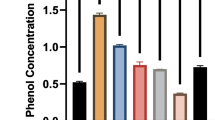Abstract
Bacteria were isolated from wastewater containing highly concentrated hydrogen peroxide that had been used to clean the pure water delivery system in a semiconductor plant. One bacterium was selected for its high hydrogen peroxide degradation activity. In the presence of 1 % hydrogen peroxide, it degraded 72.5 % in 5 min. It showed 100 % viability after 6 h at 1 % hydrogen peroxide. Even at 3 % hydrogen peroxide, it survived for more than 6 h. This bacterium was named as Bacillus nitroreducens PLC9 since its 16S rRNA showed 100 % similarity with the recently reported new species B. nitroreducens. Purified catalase from B. nitroreducens PLC9 was characterized as a thermo-alkali-stable hydroperoxidase type II catalase, and it is suggested as a new type of catalase based on following: (1) it is stable over a broad pH range (pH 4–11); (2) it is consisted of homodimers with a molecular weight of 66 kDa (total molecular weight, 134 kDa); (3) its activity was not inhibited by 3-amino-1,2,4-triazole; and (4) its N-terminal sequence has never been reported before. Both B. nitroreducens PLC9 and the isolated catalase can be used for efficient degradation of hydrogen peroxide at high concentrations.





Similar content being viewed by others
References
Kuusk, H., Björklund, M., & Rydström, J. (2001). Purification and characterization of a novel bromoperoxidase-catalase isolated from bacteria found in recycled pulp white water. Enzyme and Microbial Technology, 28, 617–624.
Sacchetti, R., De Luca, G., & Zanetti, F. (2009). Control of Pseudomonas aeruginosa and Stenotrophomonas maltophilia contamination of microfiltered water dispensers with peracetic acid and hydrogen peroxide. International Journal of Food Microbiology, 132, 162–166.
Neyens, E., Baeyens, J., Weemaes, M., & De Heyder, B. (2003). Pilot-scale peroxidation (H2O2) of sewage sludge. Journal of Hazardous Materials, 98, 91–106.
Paar, A., Costa, S., Tzanov, T., Gudelj, M., Robra, K. H., Cavaco-Paulo, A., & Gübitz, G. M. (2001). Thermo-alkali-stable catalase from newly isolated Bacillus sp. for the treatment and recycling of textile bleaching effluents. Journal of Biotechnology, 89, 147–153.
Nadler, V., Goldberg, I., & Hochman, A. (1986). Comparative study of bacterial catalases. Biochimica et Biophysica Acta, 882, 234–241.
Kim, H. P., Lee, J. S., Hah, Y. C., & Roe, J. H. (1992). Multiple catalases of Streptomyces coelicolor. Korean J of Microb, 30, 291–298.
Shi, X., Feng, M., Zhao, Y., Guo, X., & Zhou, P. (2008). Overexpression, purification and characterization of a recombination secretary catalase from Bacillus subtilis. Biotechnology Letters, 30, 181–186.
Gerhardt, P. (1994). Methods for general and molecular bacteriology (2nd ed.). Washington: American Society for Microbiology.
Claus, D., & Berkeley, R. C. W. (1972). Endospore-forming Gram-positive rods and cocci: genus Bacillus Chon. In P. H. A. Sneath, N. S. Mair, M. E. Sharpe, & J. G. Holt (Eds.), Bergey's manual of systematic bacteriology (Vol. 2, pp. 1066–1068). Baltimore: Williams & Wilkins.
Beers, R. F., Jr., & Sizer, I. W. (1952). A spectrophotometric method for measuring the breakdown of hydrogen peroxide by catalase. Journal of Biological Chemistry, 195, 133–140.
Laemmli, U. K. (1970). Cleavage of structural proteins during the assembly of the head of bacteriophage T4. Nature, 227, 680–685.
Wayne, L. G., & Diaz, G. A. (1986). A double staining method for differentiating between two classes of mycobacterial catalase in polyacrylamide electrophoresis gels. Analytical Biochemistry, 157, 89–92.
Terzenbach, D. P., & Blaut, M. (1998). Purification and characterization of a catalase from the nonsulfur phototrophic bacterium Rhodobacter sphaeroides ATH 2.4.1 and its role in the oxidative stress response. Archives of Microbiology, 169, 503–508.
Lim, H. K., Kim, Y. M., Lee, D. H., Kahng, H. Y., & Oh, D. C. (2001). Analysis of catalase from photosynthetic bacterium Rhodospirillum rubrum S1. Journal of Microbiology, 39, 168–176.
Quaratino, D., Federici, F., Petruccioli, M., Fenice, M., & D'Annibale, A. (2007). Production purification and partial characterization of a novel laccase from the white-rot fungus Panus tigrinus CBS 577.79. Anton Leeuw, 91, 57–69.
La Duc, M. T., Satomi, M., & Venkateswaran, K. (2004). Bacillus odyssey sp. nov., a round-spore-forming bacillus isolated from Mars Odyssey spacecraft. International Journal of Systematic and Evolutionary Microbiology, 54, 195–201.
Lee, I. J., & Lee, Y. N. (1995). Purification and characterization of catalase-3 of Deinococcus radiophilus. Journal of Microbiology, 33, 239–243.
Yumoto, I., Ichihashi, D., Iwata, H., Istokovics, A., Ichise, N., Matsuyama, H., Okuyama, H., & Kawasaki, K. (2000). Purification and characterization of a catalase from the facultatively psychrophilic bacterium Vibrio rumoiensis S-1T exhibiting high catalase activity. Journal of Bacteriology, 182, 99–105.
Goldberg, I., & Hochman, A. (1989). Purification and characterization of a novel type of catalase from the bacterium Klebsiella pneumonia. Biochimica et Biophysica Acta, 991, 330–336.
Hu, X., Fan, W., Han, B., Liu, H., Zheng, D., Li, Q., Dong, W., Yan, J., Gao, M., Berry, C., & Yuan, Z. (2008). Complete genome sequence of the mosquitocidal bacterium Bacillus sphaericus C3-41 and comparison with those of closely related Bacillus species. Journal of Bacteriology, 190, 2892–2902.
Allgood, G. S., & Perry, J. J. (1986). Characterization of a manganese-containing catalase from the obligate thermophile Thermoleophilum album. Journal of Bacteriology, 168, 563–567.
Wang, C. T., Chou, W. L., Kuo, Y. M., & Chang, F. L. (2009). Paired removal of color and COD from textile dyeing wastewater by simultaneous anodic and indirect cathodic oxidation. Journal of Hazardous Materials, 169, 16–22.
Safarik, I., Sabatkova, Z., & Safarikova, M. (2008). Hydrogen peroxide removal with magnetically responsive Saccharomyces cerevisiae cells. Journal of Agricultural and Food Chemistry, 56, 7925–7928.
Acknowledgments
This work was supported by a research grant from the National Research Foundation of Korea (Grant No. 511-2006-1-C00105).
Author information
Authors and Affiliations
Corresponding author
Rights and permissions
About this article
Cite this article
Hong, H., Bae, K.S. & Lee, Y. New Bacteria Bacillus nitroreducens PLC9 with Hydrogen Peroxide-Degrading Activity with High Survival Rate in Hydrogen Peroxide. Appl Biochem Biotechnol 169, 701–711 (2013). https://doi.org/10.1007/s12010-012-0034-9
Received:
Accepted:
Published:
Issue Date:
DOI: https://doi.org/10.1007/s12010-012-0034-9




